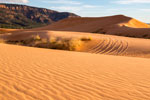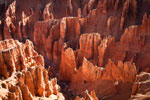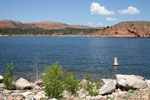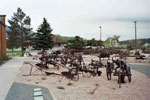Bryce Canyon
 At Bryce Canyon National Park, erosion has shaped colorful Claron limestones, sandstones, and mudstones into thousands of spires, fins, pinnacles, and mazes. Collectively called "hoodoos," these colorful and whimsical formations stand in horseshoe-shaped amphitheaters along the eastern edge of the Paunsaugunt Plateau in Southern Utah.
At Bryce Canyon National Park, erosion has shaped colorful Claron limestones, sandstones, and mudstones into thousands of spires, fins, pinnacles, and mazes. Collectively called "hoodoos," these colorful and whimsical formations stand in horseshoe-shaped amphitheaters along the eastern edge of the Paunsaugunt Plateau in Southern Utah.
Coral Pink Sand Dunes State Park
 Twelve miles off U.S. Highway 89 near Kanab, lies the wide-sweeping expanse of Coral Pink Sand Dunes State Park. It is a wonderful place for riding off-highway vehicles, taking photographs or just playing in the sand. The park has a 22 unit pull-through campground, modern rest rooms, showers, waste disposal station and blacktop roads.
Twelve miles off U.S. Highway 89 near Kanab, lies the wide-sweeping expanse of Coral Pink Sand Dunes State Park. It is a wonderful place for riding off-highway vehicles, taking photographs or just playing in the sand. The park has a 22 unit pull-through campground, modern rest rooms, showers, waste disposal station and blacktop roads.
Cedar Breaks National Monument
 A huge natural amphitheater has been eroded out of the variegated Pink Cliffs (Claron Formation) near Cedar City, Utah. Millions of years of sedimentation, uplift and erosion have created a deep canyon of rock walls, fins, spires and columns, that spans some three miles, and is over 2,000 feet deep.
A huge natural amphitheater has been eroded out of the variegated Pink Cliffs (Claron Formation) near Cedar City, Utah. Millions of years of sedimentation, uplift and erosion have created a deep canyon of rock walls, fins, spires and columns, that spans some three miles, and is over 2,000 feet deep.
Gunlock Reservoir State Park
 In scenic red rock country, 15 miles northwest of sunny St. George lies the 240-acre Gunlock Reservoir where year-round boating, water sports and quality fishing for bass and catfish attract visitors. Facilities include boat launching ramp and pit privies. The name Gunlock is the same as the small farming community one mile to the north.
In scenic red rock country, 15 miles northwest of sunny St. George lies the 240-acre Gunlock Reservoir where year-round boating, water sports and quality fishing for bass and catfish attract visitors. Facilities include boat launching ramp and pit privies. The name Gunlock is the same as the small farming community one mile to the north.
Quail Creek Reservoir State Park
 Boasting some of the warmest waters in the state and a mild winter climate, Quail Creek Reservoir lures boaters and anglers year-round. Anglers fish for rainbow trout and bass. Spend a day on the water or visit a nearby state or national park, then retire to a campsite in a spectacular red rock desert setting. Quail Creek State Park provides excellent year-round camping, picnicking, boating, and trout and bass fishing in sunny southwest Utah.
Boasting some of the warmest waters in the state and a mild winter climate, Quail Creek Reservoir lures boaters and anglers year-round. Anglers fish for rainbow trout and bass. Spend a day on the water or visit a nearby state or national park, then retire to a campsite in a spectacular red rock desert setting. Quail Creek State Park provides excellent year-round camping, picnicking, boating, and trout and bass fishing in sunny southwest Utah.
Frontier Homestead State Park & Museum
 Frontier Homestead State Park Museum tells the story of development in Iron County when in the 1850s, Brigham Young sent Mormon missionaries here to mine and process iron. Museum displays include horse-drawn vehicles used from 1850 to 1920 and a collection of pioneer artifacts.
Frontier Homestead State Park Museum tells the story of development in Iron County when in the 1850s, Brigham Young sent Mormon missionaries here to mine and process iron. Museum displays include horse-drawn vehicles used from 1850 to 1920 and a collection of pioneer artifacts.
Old Iron Town Ruins
 During the 1850's in hopes of increasing the self- sufficiency of Utah, Brigham Young sent members of the Church Of Jesus Christ of Latter Day Saints to the Iron Mission in what is now Cedar City, Utah. Approximately ten years after the iron works of Cedar city closed, Peter Shirts discovered the site of Iron City. In June of 1868 Ebenezer Hanks organized the Union Iron Company.
During the 1850's in hopes of increasing the self- sufficiency of Utah, Brigham Young sent members of the Church Of Jesus Christ of Latter Day Saints to the Iron Mission in what is now Cedar City, Utah. Approximately ten years after the iron works of Cedar city closed, Peter Shirts discovered the site of Iron City. In June of 1868 Ebenezer Hanks organized the Union Iron Company.
Jacob Hamblin Home
 Jacob Hamblin was born 6 April 1819 in Ashtabula County, Ohio. His parents were farmers, and he learned farming a youth. In 1836 his family moved to Wisconsin Territory and homesteaded at a place called Spring Prairie. Hamblin's father told Jacob when he was nineteen that he had been a faithful boy and that it was time for him to go into the world and do something for himself.
Jacob Hamblin was born 6 April 1819 in Ashtabula County, Ohio. His parents were farmers, and he learned farming a youth. In 1836 his family moved to Wisconsin Territory and homesteaded at a place called Spring Prairie. Hamblin's father told Jacob when he was nineteen that he had been a faithful boy and that it was time for him to go into the world and do something for himself.
Leeds CCC Camp
 Built in 1933, the Leeds Civilian Conservation Corps Camp is significant as perhaps the best remaining example of a CCC camp in Utah. These camps were typically built of relatively temporary frame construction, and the surviving buildings and features such as the stone terraces at the Leeds camp present a unique, if somewhat limited, view of these important facilities.
Built in 1933, the Leeds Civilian Conservation Corps Camp is significant as perhaps the best remaining example of a CCC camp in Utah. These camps were typically built of relatively temporary frame construction, and the surviving buildings and features such as the stone terraces at the Leeds camp present a unique, if somewhat limited, view of these important facilities.
Orson Adams House And Harrisburg Utah
 From 1864 until the early 1890s, Orson B. Adams, his wife Susannah, two sons, and eventually two granddaughters lived in this two-room sandstone dwelling. They were among the nine families "called" in 1861 by the Church of Jesus Christ of Latter Day Saints to settle at the confluence of Leeds and Quail Creeks; the new settlement was named Harrisburg. Willard G. McMullin, a master stone mason, arrived here in 1862 and constructed the Adams home, as well as many of the other residences of Harrisburg, during the period between 1863 and 1865.
From 1864 until the early 1890s, Orson B. Adams, his wife Susannah, two sons, and eventually two granddaughters lived in this two-room sandstone dwelling. They were among the nine families "called" in 1861 by the Church of Jesus Christ of Latter Day Saints to settle at the confluence of Leeds and Quail Creeks; the new settlement was named Harrisburg. Willard G. McMullin, a master stone mason, arrived here in 1862 and constructed the Adams home, as well as many of the other residences of Harrisburg, during the period between 1863 and 1865.
Mountain Meadows Massacre of 1857
 In April 1857 a California-bound wagon train estimated at 40 wagons, 120 to 150 men, women, and children, and as many as 900 head of beef cattle, in addition to draft and riding animals, assembled near the Crooked Creek, approximately four miles south of present-day Harrison, Arkansas. Most of these emigrants were from northwestern Arkansas and were families, relatives, friends, and neighbors.
In April 1857 a California-bound wagon train estimated at 40 wagons, 120 to 150 men, women, and children, and as many as 900 head of beef cattle, in addition to draft and riding animals, assembled near the Crooked Creek, approximately four miles south of present-day Harrison, Arkansas. Most of these emigrants were from northwestern Arkansas and were families, relatives, friends, and neighbors.
Hiking Snow Canyon
 Snow Canyon offers beautiful day hike's through red and white Navajo sandstone, capped by black lava rock. Before hiking in a desert environment like Snow Canyon make sure you are prepared. Carry at least one liter of water per person. Do not hike alone. Avoid hiking when temperatures are extreme. Otherwise keep your hike short, wear a hat and sunscreen, and bring water.
Snow Canyon offers beautiful day hike's through red and white Navajo sandstone, capped by black lava rock. Before hiking in a desert environment like Snow Canyon make sure you are prepared. Carry at least one liter of water per person. Do not hike alone. Avoid hiking when temperatures are extreme. Otherwise keep your hike short, wear a hat and sunscreen, and bring water.
Red Cliffs Recreation Area
 Red Cliffs Recreation Area is located just off of I-15, 15 miles north of St George, Utah near Quail Creek. Red Cliffs is a charming year-round camping area, but particularly attractive in the Fall and Spring of the year when the cold settles in the north. The cliffs protect the campground from the harsh winter winds. When it is icy in the north, Red Cliffs is a pleasant place to enjoy the warmth of the sun. Summers can be hot within the rock enclosure.
Red Cliffs Recreation Area is located just off of I-15, 15 miles north of St George, Utah near Quail Creek. Red Cliffs is a charming year-round camping area, but particularly attractive in the Fall and Spring of the year when the cold settles in the north. The cliffs protect the campground from the harsh winter winds. When it is icy in the north, Red Cliffs is a pleasant place to enjoy the warmth of the sun. Summers can be hot within the rock enclosure.
Sand Hollow Reservoir State Park
 With its warm, blue waters and red sandstone landscape, Utah's newest state park is also one of its most popular. Boat and fish on Sand Hollow Reservoir, explore and ride the dunes of Sand Mountain on an off-highway vehicle, then RV or tent camp in the new campground. The sprawling 20,000-acre park, which rests mostly on USDI Bureau of Land Management (BLM) land, rivals Utah's two largest state parks - Wasatch Mountain and Antelope Island.
With its warm, blue waters and red sandstone landscape, Utah's newest state park is also one of its most popular. Boat and fish on Sand Hollow Reservoir, explore and ride the dunes of Sand Mountain on an off-highway vehicle, then RV or tent camp in the new campground. The sprawling 20,000-acre park, which rests mostly on USDI Bureau of Land Management (BLM) land, rivals Utah's two largest state parks - Wasatch Mountain and Antelope Island.
Sand Hollow Reservoir ATV Area
 While vacationing in the St George area the family and I decided to take a day and visit Sand Hollow Reservoir. Hearing about the 15,000 acre stretch of red sand dunes, we made sure we had are four wheelers in tow. The dunes are on the south side of the reservoir. When you arrive at the dunes don't be deceived by narrow appearance of the dunes. When you crest the first hill you will discover the dunes go on and on.
While vacationing in the St George area the family and I decided to take a day and visit Sand Hollow Reservoir. Hearing about the 15,000 acre stretch of red sand dunes, we made sure we had are four wheelers in tow. The dunes are on the south side of the reservoir. When you arrive at the dunes don't be deceived by narrow appearance of the dunes. When you crest the first hill you will discover the dunes go on and on.